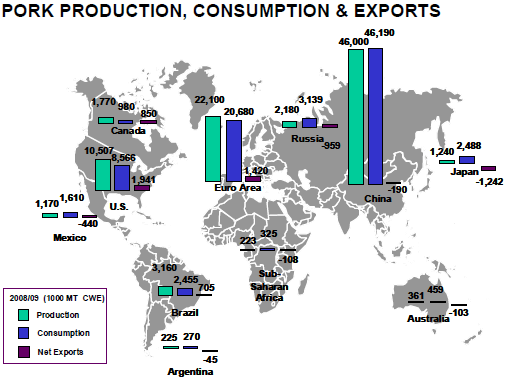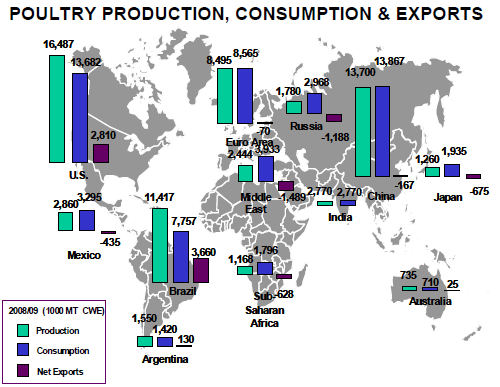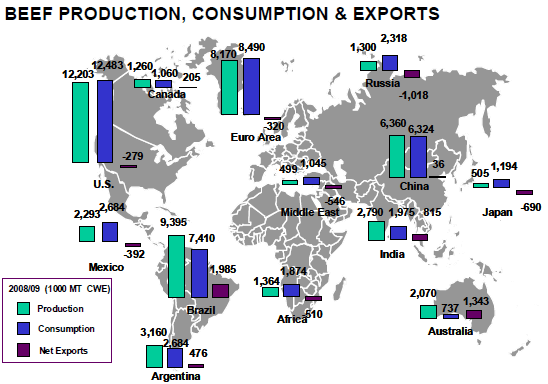



CME: Global Consumption, Production and Trade Patterns
US - CME's Daily Livestock Report for 15 January 2009.Worldwide meat consumption, production and trade patterns have become quite important to producers and processors of every type of meat and poultry. The graphics in today’s edition, used courtesy of Ricardo Scaff of Rabobank International, provide an interesting snapshot of those patterns. All of the data are from USDA and The World Bank. The first item at left shows per capita consumption of pork, broilers and beef as well as GDP per capita while the other three below show total production, consumption and exports of each of the tmajor animal proteins.




Some interesting items include:
- The “non-correlation” of meat consumption and per capita GDP. While it is true that meat consumption almost always rises as GDP goes up — ie. that the marginal propensity to spend on meat is large — high per cap GDP is not a pre-requisite for high meat consumption. Argentina and Brazil are the best examples. On the other extreme is Japan which has a relatively high per cap GDP but whose annually per cap total consumption falls short of 100 pounds.
- South America may be a potential pork juggernaut with its grain production capacity but don’t expect South Americans to eat much of that pork! Except for India (which has a bit of a religious problem with pork) and South Africa, Brazil and Argentina have the lowest per capita consumption rates for pork among the countries shown here.
- Pork production is FAR less geographically dispersed than are beef and poultry production. Upon reflection, that should not be much of a surprise. First, pork faces some cultural and religious restrictions not faced by beef and chicken. Second, cattle can effectively utilize forages and much of the beef produced outside of the United States, Canada and Australian depends almost solely on forages. Thus, beef output is somewhat freed from dependence on cultivated land and crop production. Finally, chickens are the most feed-efficient of the species making them the choice in many places with limited grain supplies or high grain costs. In addition, chicken faces fewer religious restrictions than either of the other meats, making it much more important in the Middle East and India.
- Pork’s status as the world’s most consumed meat (it owns 42 per cent of world meat consumption in 207) is VERY, VERY dependent on pork’s huge market share in China. If the contest involves the volume of any product, winning in China is a good, good thing! Further, China’s pork output swamps that of the remainder of the world. It is difficult to grasp the number of pigs and amount of pork produced in China and these number put into perspective a) the importance of the large death losses encountered in 2006 and 2007 due to disease, harsh winter weather and earthquakes and b) the effort that is being made to rebuild China’s pork production capacity.
- The fact that poultry is the most widely traded of the three proteins in world markets. Pork is the least traded of the three, a result, according to the U.S. National Pork Producers Council, of pork being the most protected industry of the three by many countries.











